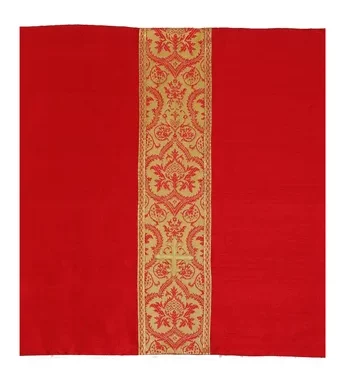
To test a pattern for a Chalice Veil at Ecclesiastical Sewing, red silk dupioni was used for the face fabric, satin for the lining, and Evesham brocade for the orphrey band, trimmed with Saint Benet trim. The process involved measuring, cutting, and adding the orphrey band and trim. Basting the trim before sewing helped ensure it stayed straight. After completing the orphrey band, it was stitched to the silk, a cross was applied with an iron, and the lining was hand-stitched. The final result is a beautiful Chalice Veil in the Saint Gregory Collection of Vestments.
Like this:
Like Loading...

Ecclesiastical Sewing sells small iron-on cross appliques. There are a variety of colors and sizes. These little crosses can be used on the neckline of a stole; they can be used to decorate the front of a stole; or they could be used on chalice veils, burses, or other church vestments.
Like this:
Like Loading...

Celebrate the 500th Reformation Anniversary with Ecclesiastical Sewing’s VDMA Cross Embroidery Designs. Available for machine embroidery, these designs honor the enduring Word of the Lord. Artist Edward Riojas collaborates on upcoming designs inspired by the Catechism’s six chief parts.
Like this:
Like Loading...
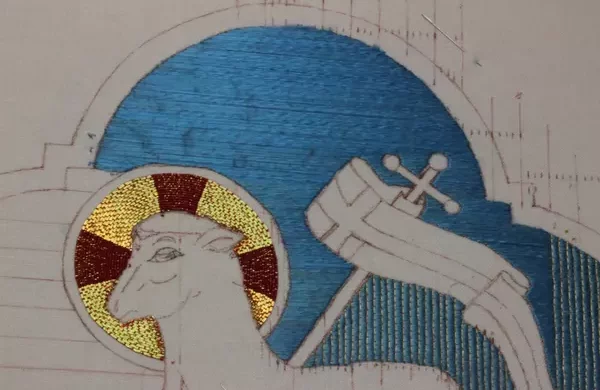
The Two Agnus Die projects for the Easter Set, the gold thread used for couching the blue silk sky is a Gilt Smooth Passing Thread size 4 with a silk core. The thread is imported from Access Commodities here in the States and is available from Hedgehog Handworks. The Gilt threads have 1/2% gold and are very nice to work with. The silk core makes the thread very pliable and so nice to plunge thread tails – an excellent goldwork thread.
Like this:
Like Loading...
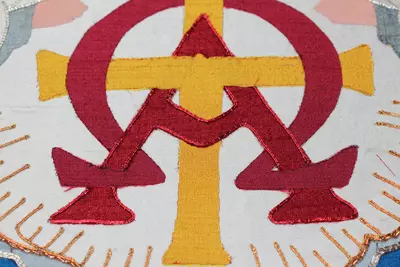
The Red Cord was used to couch the Red Passing thread. It worked great from the start, for about 3 stitches. Then, as the metallic cord was pulled through the fabric, the cord separated, showing the white core.
Like this:
Like Loading...

In Ecclesiastical Sewing projects, planning ahead – For the IHS Goldwork Design on Rose Vestments, new techniques are being considered. One option involves cutting IHS letters from card and padding with gold wire thread. Getting accurate shapes was a challenge, but found Pellon Clear Fuse, which worked well for tracing the letters onto card padding.
Like this:
Like Loading...
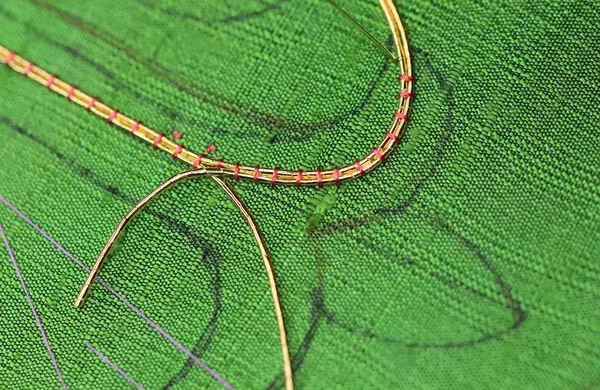
IHS Goldwork Embroidery for the Rose Vestment Set Altar Frontal. Inspired by a detailed Fleur end in a design notebook, Silk Wrapped Purl was used for the cross. The technique involves a central line splitting into two at the Fleur ends. Adding a second gold thread using the “turn one, cut one method” from the A to Z Goldwork Book by Inspirations
Like this:
Like Loading...

Tips and techniques that can make goldwork progress
– IHS Ecclesiastical Embroidery Design for a Rose Vestment Set. Using the couching technique, she starts with horizontal and vertical rows, opting for a turn-one, plunge-one method to manage thread ends. The needle is placed between gold threads, angled under the previous row, and pulled tight. The chosen couching style creates a brick pattern with alternating stitch placement…
Like this:
Like Loading...
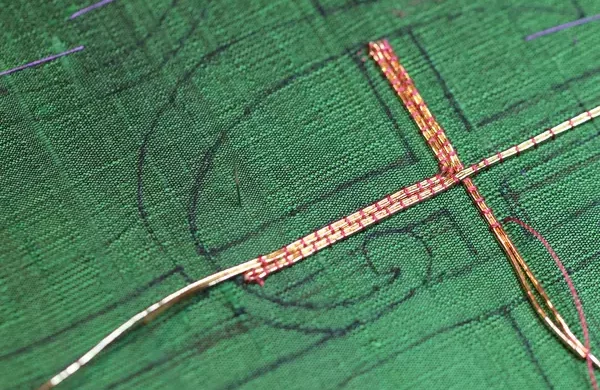
At the start of the goldwork embroidery project, there were some issues. The gold threads got stuck and wouldn’t go through as planned. Despite trying different things, they just wouldn’t cooperate. The problem was found—it was the muslin backing causing entanglement between layers. So, the decision was made to start over. The silk dupioni was securely attached to the Alba Maxima Linen, allowing for corrections. This time, the plan is to stitch from the center outward, hoping for a smoother process.
Like this:
Like Loading...

In the Agnus Dei Ecclesiastical Embroidery Project, significant progress has been made on the upper sky. Using long-laid stitches and horizontal guide marks, the detailed stitching maintains parallel and straight alignment. Frequent thread changes are necessary due to the 6 1/2″ stitch width, but the process speeds up as intricate details around the cross are left behind. The joy of completing a major portion of the sky-laid work is evident, with two-thirds now finished.
Like this:
Like Loading...

The update on the larger of the Agnus Dei pieces’ from The Tale of Two Lambs.
Like this:
Like Loading...
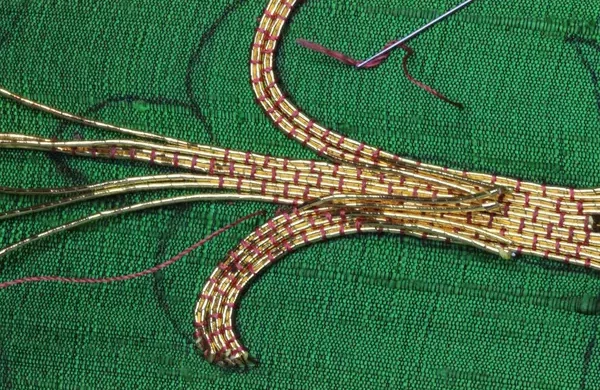
Working on the IHS Ecclesiastical Embroidery with gold threads is exciting. The sparkle and shine bring joy, but dealing with the cross ends is a bit tricky. Inspired by a vintage banner, branching gold threads from the center and facing challenges with plunging through three fabric layers. Considering adjustment for the better results. Happy stitching dreams!
Like this:
Like Loading...
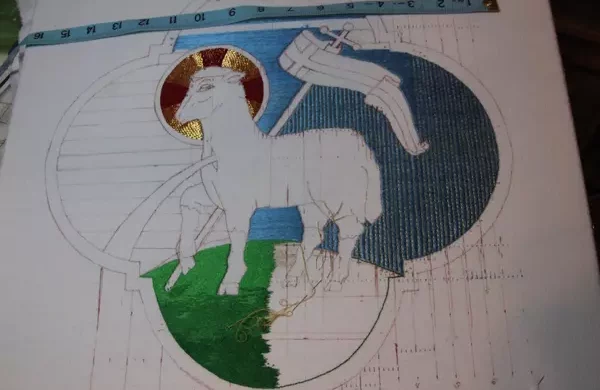
The Ecclesiastical Embroidery Design for the Altar Frontal features the largest Lamb, measuring about 15″ in width. The sky is stitched in Royal Floss, a vivid blue from the Belding Brothers Company. Goldwork details use #4 Smooth Passing with Silk Core from Access Commodities. The design aims for a bright and radiant sky, symbolizing the glorious Resurrection.
Like this:
Like Loading...
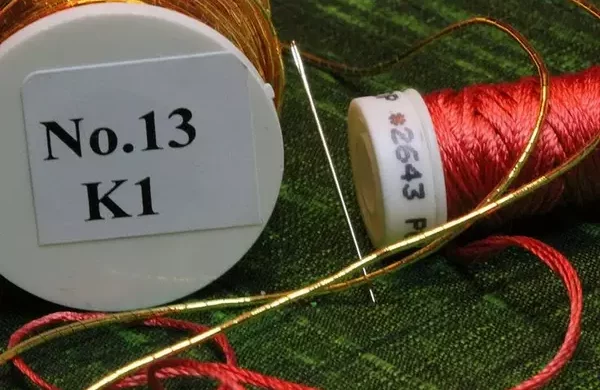
Starting on a new embroidery project brings joy and excitement. The initial stitches on the Rose Set IHS Ecclesiastical Embroidery Design mark the beginning of creative possibilities. The goal is a stunning, “bread and butter” style of goldwork embroidery, keeping it simple with no extra padding and special techniques,
Like this:
Like Loading...
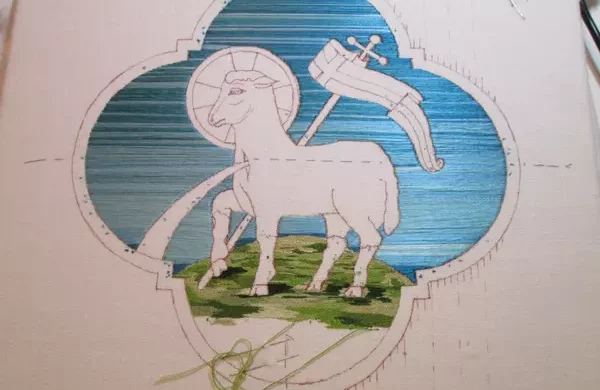
Starting with a small Agnus Dei hand embroidery design, The Tale of Two Lambs turned into two projects – in sizes small and large. Limited Ecclesiastical designs led to this traditional choice. The smaller Agnus Dei, at 8 1/2″, fits a chasuble’s back. As the project continued, minor changes improved the second design. The small lamb’s hill, initially stitched in camouflage green, became serene blue. Using Soie Ovale for the sky presented challenges, but the finished product was pleasing. Careful placement of gold passing thread helped secure the silk strands, enhancing the design.
Like this:
Like Loading...
















You must be logged in to post a comment.